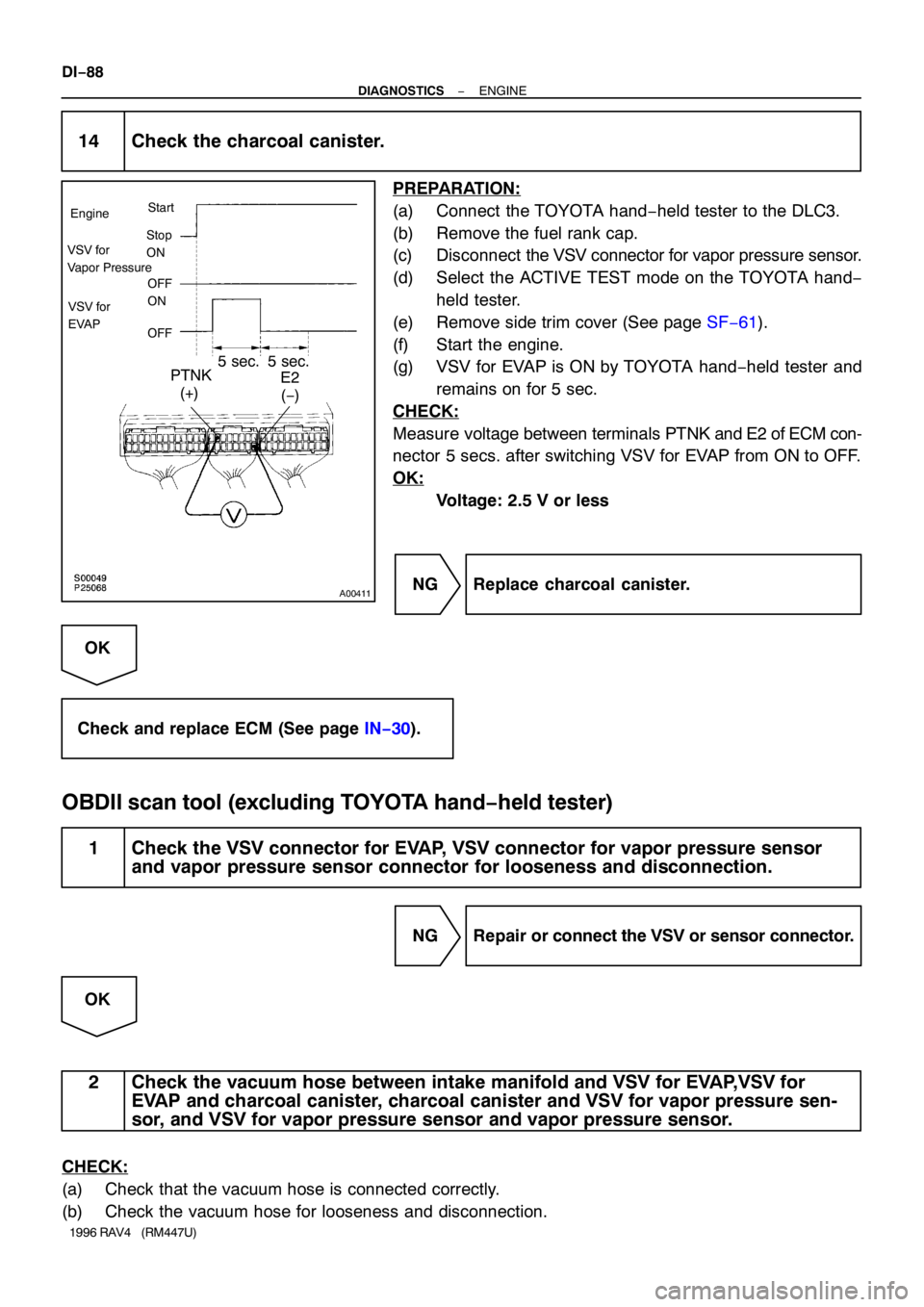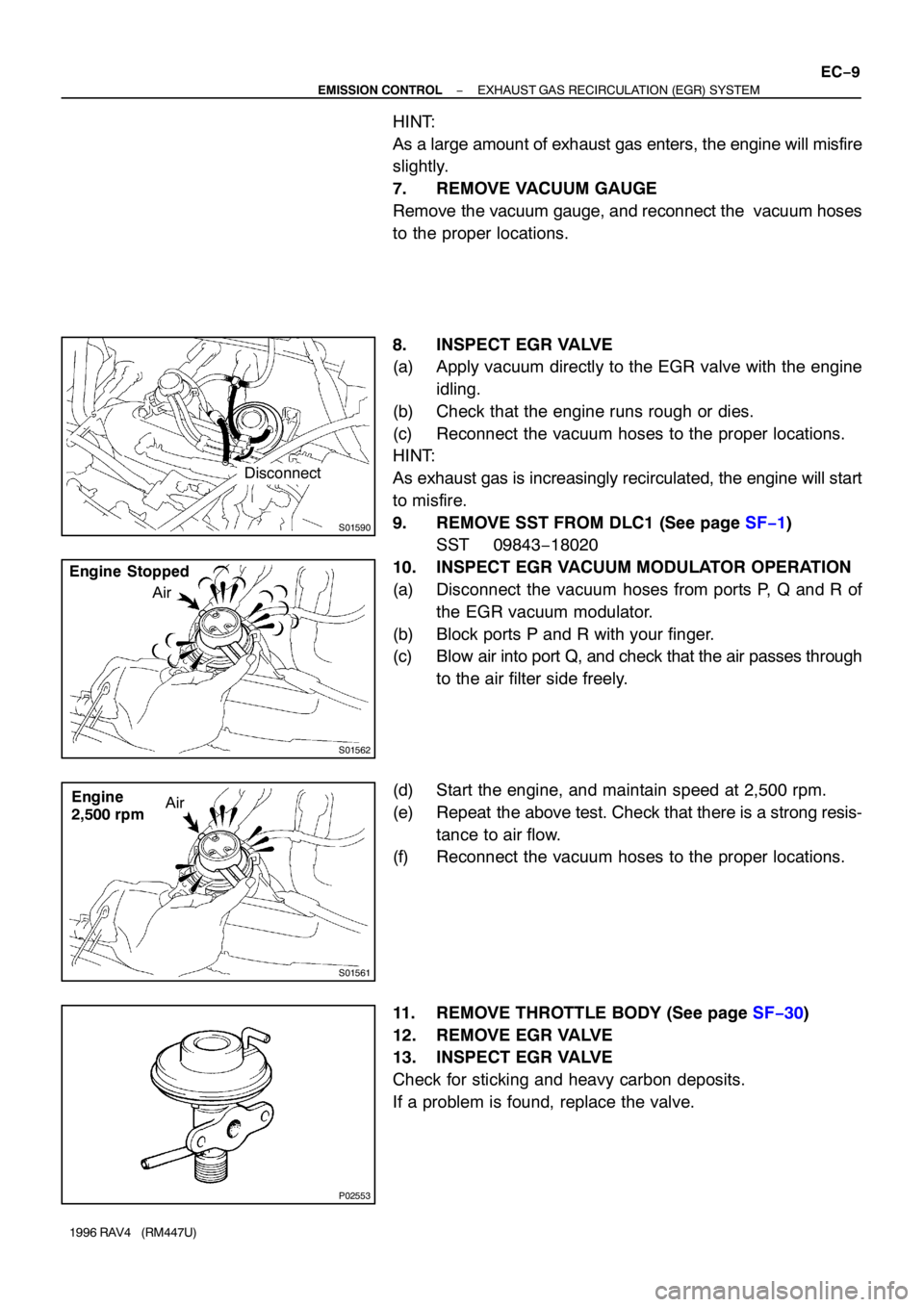Page 408 of 1354

A00411
Engine
VSV for
Vapor Pressure
VSV for
EVAP
OFF OFF
ON Stop
ONStart
5 sec. 5 sec.
PTNK
(+)E2
(−)
DI−88
− DIAGNOSTICSENGINE
1996 RAV4 (RM447U)
14 Check the charcoal canister.
PREPARATION:
(a) Connect the TOYOTA hand−held tester to the DLC3.
(b) Remove the fuel rank cap.
(c) Disconnect the VSV connector for vapor pressure sensor.
(d) Select the ACTIVE TEST mode on the TOYOTA hand−
held tester.
(e) Remove side trim cover (See page SF−61).
(f) Start the engine.
(g) VSV for EVAP is ON by TOYOTA hand−held tester and
remains on for 5 sec.
CHECK:
Measure voltage between terminals PTNK and E2 of ECM con-
nector 5 secs. after switching VSV for EVAP from ON to OFF.
OK:
Voltage: 2.5 V or less
NG Replace charcoal canister.
OK
Check and replace ECM (See page IN−30).
OBDII scan tool (excluding TOYOTA hand−held tester)
1 Check the VSV connector for EVAP, VSV connector for vapor pressure sensor
and vapor pressure sensor connector for looseness and disconnection.
NG Repair or connect the VSV or sensor connector.
OK
2 Check the vacuum hose between intake manifold and VSV for EVAP,VSV for
EVAP and charcoal canister, charcoal canister and VSV for vapor pressure sen-
sor, and VSV for vapor pressure sensor and vapor pressure sensor.
CHECK:
(a) Check that the vacuum hose is connected correctly.
(b) Check the vacuum hose for looseness and disconnection.
Page 409 of 1354
− DIAGNOSTICSENGINE
DI−89
1996 RAV4 (RM447U)
(c) Check the vacuum hose for cracks, hole, damage and blockage.
NG Repair or replace.
OK
3 Check voltage between terminals VC and E2 of ECM connector
(See page DI−76, step 9).
NG Check and replace ECM (See page IN−30).
OK
4 Check voltage between terminals PTNK and E2 of ECM connector
(See page DI−76, step 10).
OK Go to step 6.
NG
5 Check for open and short in harness and connector between vapor pressure
sensor and ECM (See page IN−30).
NG Repair or replace harness or connector.
OK
Replace vapor pressure sensor.
Page 658 of 1354

EC05I−03
EC3069Check Valve (Vacuum Valve)Gasket
S01428
S01451
Port E
Port D
Port A
Compressed
Air
Port B
S01452
Port C Port D Port A
Compressed
Air
Port B
− EMISSION CONTROLEVAPORATIVE EMISSION (EVAP) CONTROL SYSTEM
EC−5
1996 RAV4 (RM447U)
EVAPORATIVE EMISSION (EVAP)
CONTROL SYSTEM
INSPECTION
1. VISUALLY INSPECT LINES AND CONNECTIONS
Look for loose connections, sharp bends or damage.
2. VISUALLY INSPECT FUEL TANK
Look for deformation, cracks or fuel leakage.
3. VISUALLY INSPECT FUEL TANK CAP
Check if the cap and/or gasket are deformed or damaged.
If necessary, repair or replace the cap.
4. DISCONNECT EVAP HOSES FROM CHARCOAL CAN-
ISTER
5. VISUALLY INSPECT CHARCOAL CANISTER
Look for cracks or damage.
6. CHECK FOR CLOGGED FILTER, AND STUCK CHECK
VALVE AND DIAPHRAGM
(a) Install a plug to port E.
(b) While holding port B closed, blow air (1.76 kPa, 18
gf/cm
2, 0.26 psi) into port A and check that air flows from
port D.
(c) While holding port B and port D closed, blow air (1.76 kPa,
18 gf/cm
2, 0.26 psi) into port A and check that air does not
flow from port C.
Page 659 of 1354
S01453
Port B
Port C
S01454
Port A
Port BPort C EC−6
− EMISSION CONTROLEVAPORATIVE EMISSION (EVAP) CONTROL SYSTEM
1996 RAV4 (RM447U)
(d) Apply vacuum (3.43 kPa, 26 mmHg, 1.01 in.Hg) to port B,
check that the vacuum does not decrease when port C is
closed, and check that the vacuum decreases when port
C is released.
(e) While holding port C closed, apply vacuum (1.23 kPa, 9.2
mmHg, 0.36 in.Hg) to port A and check that air flows into
port B.
If a problem is found, replace the charcoal canister.
(f) Remove the plug.
7. RECONNECT EVAP HOSES
8. INSPECT VSV FOR EVAP (See page SF−45)
9. INSPECT VSV FOR VAPOR PRESSURE SENSOR (See
page SF−47)
10. INSPECT VAPOR PRESSURE SENSOR (See page
SF−55)
Page 661 of 1354

EC05K−03
S01587
Cap
Filter
S01588
Vacuum
Gauge
S01261
DLC1
TE1
E1SST
S01589
High Vacuum
at 2,500 rpm
Port R
Disconnect HOT EC−8
− EMISSION CONTROLEXHAUST GAS RECIRCULATION (EGR) SYSTEM
1996 RAV4 (RM447U)
INSPECTION
1. INSPECT AND CLEAN FILTER IN EGR VACUUM MOD-
ULATOR
(a) Remove the cap and filter.
(b) Check the filter for contamination or damage.
(c) Using compressed air, clean the filter.
(d) Reinstall the filter and cap.
HINT:
Install the filter with the coarser surface facing the atmospheric
side (outward).
2. INSTALL VACUUM GAUGE
Using a 3−way connector, connect a vacuum gauge to the hose
between the EGR valve and VSV.
3. INSPECT SEATING OF EGR VALVE
Start the engine and check that the engine starts and runs at
idle.
4. CONNECT TERMINALS TE1 AND E1 OF DLC1
Using SST, connect terminals TE1 and E1 of the DLC1
SST 09843−18020
5. INSPECT VSV OPERATION WITH COLD ENGINE
(a) The engine coolant temperature should be below
55°C (131°F).
(b) Check that the vacuum gauge indicates zero at 2,500
rpm.
6. INSPECT OPERATION OF VSV AND EGR VACUUM
MODULATOR WITH HOT ENGINE
(a) Warm up the engine to above 60°C (140°F).
(b) Check that the vacuum gauge indicates low vacuum at
2,500 rpm.
(c) Disconnect the vacuum hose port R of the EGR vacuum
modulator and connect port R directly to the intake man-
ifold with another hose.
(d) Check that the vacuum gauge indicates high vacuum at
2,500 rpm.
Page 662 of 1354

S01590
Disconnect
S01562
Engine Stopped
Air
S01561
Engine
2,500 rpmAir
P02553
− EMISSION CONTROLEXHAUST GAS RECIRCULATION (EGR) SYSTEM
EC−9
1996 RAV4 (RM447U)
HINT:
As a large amount of exhaust gas enters, the engine will misfire
slightly.
7. REMOVE VACUUM GAUGE
Remove the vacuum gauge, and reconnect the vacuum hoses
to the proper locations.
8. INSPECT EGR VALVE
(a) Apply vacuum directly to the EGR valve with the engine
idling.
(b) Check that the engine runs rough or dies.
(c) Reconnect the vacuum hoses to the proper locations.
HINT:
As exhaust gas is increasingly recirculated, the engine will start
to misfire.
9. REMOVE SST FROM DLC1 (See page SF−1)
SST 09843−18020
10. INSPECT EGR VACUUM MODULATOR OPERATION
(a) Disconnect the vacuum hoses from ports P, Q and R of
the EGR vacuum modulator.
(b) Block ports P and R with your finger.
(c) Blow air into port Q, and check that the air passes through
to the air filter side freely.
(d) Start the engine, and maintain speed at 2,500 rpm.
(e) Repeat the above test. Check that there is a strong resis-
tance to air flow.
(f) Reconnect the vacuum hoses to the proper locations.
11. REMOVE THROTTLE BODY (See page SF−30)
12. REMOVE EGR VALVE
13. INSPECT EGR VALVE
Check for sticking and heavy carbon deposits.
If a problem is found, replace the valve.
Page 667 of 1354

EM0EG−02
S01353
CO/HC Meter
− ENGINE MECHANICALCO/HC
EM−1
1996 RAV4 (RM447U)
CO/HC
INSPECTION
HINT:
This check is used only to determine whether or not the idle CO/
HC complies with regulations.
1. INITIAL CONDITIONS
(a) Engine at normal operating temperature
(b) Air cleaner installed
(c) All pipes and hoses of air induction system connected
(d) All accessories switched OFF
(e) All vacuum lines properly connected
HINT:
All vacuum hoses for EGR systems, etc. should be properly
connected.
(f) SFI system wiring connectors fully plugged
(g) Ignition timing check correctly
(h) Transmission in neutral position
(i) Tachometer and CO/HC meter calibrated by hand.
2. START ENGINE
3. RACE ENGINE AT 2,500 RPM FOR APPROX. 180 SE-
CONDS
4. INSERT CO/HC METER TESTING PROBE AT LEAST
40 cm (1.3 ft) INTO TAILPIPE DURING IDLING
5. IMMEDIATELY CHECK CO/HC CONCENTRATION AT
IDLE AND/OR 2,500 RPM
Complete the measuring within 3 minutes.
HINT:
When performing the 2 mode (2,500 rpm and idle) test, follow
the measurement order prescribed by the applicable local regu-
lations.
Page 668 of 1354

EM−2
− ENGINE MECHANICALCO/HC
1996 RAV4 (RM447U)
6. TROUBLESHOOTING
If the CO/HC concentration does not comply with regulations,
troubleshoot in the order given below.
(a) Check the oxygen sensor operation (See page DI−42).
(b) See the table below for possible causes, then inspect and
correct the applicable causes if necessary.
HCCOProblemsCauses
HighNormalRough idle4. Faulty ignitions:
�Incorrect timing
�Fouled, shorted or improperly gapped plugs
�Open or or crossed high−tension cords
�Cracked distributor cap
5. Incorrect valve clearance
6. Leaky EGR valve
7. Leaky intake and exhaust valves
8. Leaky cylinder
HighLowRough idle
(Fluctuating HC reading)1. Vacuum leaks:
�PCV hose
�EGR valve
�Intake manifold
�Throttle body
�IAC valve
�Brake booster line
2. Lean mixture causing misfire
HighHighRough idle
(Black smoke from exhaust)1. Restricted air filter
2. Faulty SFI system:
�Faulty pressure regulator
�Clogged fuel return line
�Defective ECT sensor
�Defective IAT sensor
�Faulty ECM
�Faulty injector
�Faulty throttle position sensor
�MAP sensor